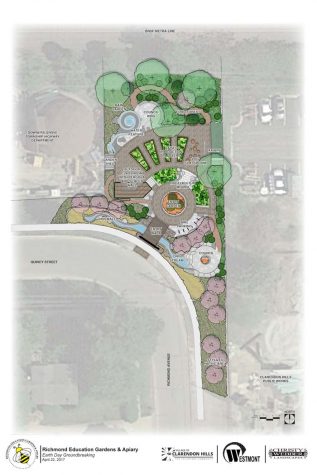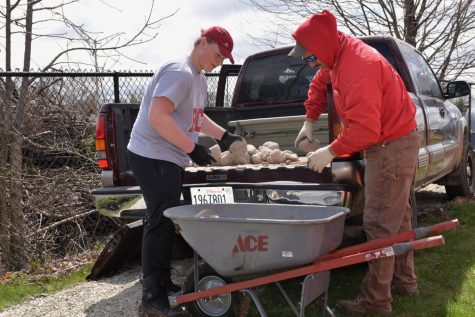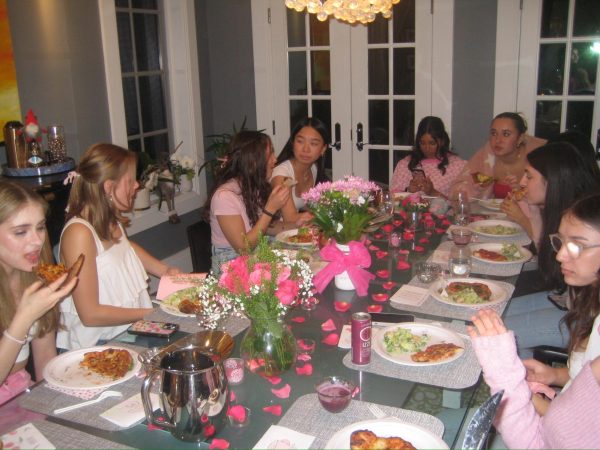Junior takes environmentalism into his own hands
Junior Luke Leddy built a rain garden that would be a part of the Richmond Garden and Apiary in Westmont.
Junior Luke Leddy always knew he wanted to do some kind of environmentally-based project in order to obtain the Eagle Scout rank he has been seeking since joining the Boy Scouts in sixth grade. So, Leddy decided to build the rain garden that was a key element of a planned design for the Richmond Education Gardens and Apiary located at 1 South Richmond Ave. in Clarendon Hills.
He gathered volunteers from his own boy scout Troop 52 and others to help. They built the rain garden on Friday, April 19 and Saturday, April 20, working from 9:00 a.m. to 5:00 p.m. There were two different crews who worked four hour shifts, while Leddy worked for all eight hours both days.
“[I volunteered to work on the rain garden] because it is a good thing to do in the community and to help [Luke] achieve his goal,” said Cole Harris, junior and member of Troop 52. “I enjoyed [working on the rain garden] and it was fulfilling to make something for the community.”

The finished Richmond Gardens and Apiary will feature a rain garden, water feature, apiary and more.
The Richmond Garden and Apiary is a combined project between the village of Westmont and Clarendon Hills, with local schools taking advantage of a more hands-on learning opportunity. The gardens first started when retired Clarendon Hills Police Chief and Beekeeper Ted Jenkins suggested the idea in order to educate future generations about the importance of bees to the environment. The finished garden will have an apiary where beehives and bees will be kept, surrounded by native plants and even a water feature.
The rain garden’s function is to filter pollutants in stormwater runoff using native plants and flowers like the Oaks Edge. The rain water would not be wasted by flowing into storm drains as it would help keep the plants alive. The whole garden itself will also serve the purpose of becoming an outdoor educational classroom in which local public schools like Walker and Prospect Elementary School can visit and teach students about the environment and sustainability.
“I feel like [Madison’s] outdoor educational classroom has done a lot for Madison [Elementary School] so this garden will be great for education [too],” said Teddy Grunow, a fifth-grader at Madison.
The gardens had been delayed for two years, after being created on Earth Day in 2017, before Leddy decided to kickstart the project again. He garnered almost $2,000 in plant and supplies donations, spending around 50 hours planning and designing the rain garden, securing donations and consulting area scout leaders.

Up to $2,000 of plants and supplies were donated by companies like Tameling’s Landscape Supply.
“Designing the garden is what took most of the time; we had to ensure that the plants could withstand salt due to the salt storage near the garden, and that it could tolerate warm and cold temperatures as well as being a rain garden plant,” Leddy said. “The layout of where the plants [would] go was also important as certain plants require more shade or need to be in standing water in order to survive.”
The first day of building the rain garden mainly consisted of digging through the soil to prepare it for the planting the next day.
Back in 2017, Mark Wollschlaeger, then an AP Environmental Science teacher, was contacted and asked if he and his students could get involved in the creation of the gardens. The components for the garden had been already decided so Wollschlaeger’s students created informational/museum signs that would inform those walking through the garden’s different sections what it was, how it works, why it is important, and how you could incorporate it at your own house.
“I think [the rain garden] was a great idea. I was an Eagle Scout and coming up with that project idea [was] always one of the most difficult parts,” Wollschlaeger said. “The nice thing about [Luke’s] project is that as long as [the rain garden] is maintained it’s not like ‘I did it, it’s over, it’s gone and nobody benefits’ after it’s over with. This is a project that [for] generations to come, rewards for the community [will] be reaped year after year because of one student’s effort.”
His students worked over the course of a couple months and made a presentation in the library on Earth Day about the components of the community garden to invited middle school kids.
To become an Eagle Scout the requirements are lengthy and extensive with only about six percent of Boy Scouts going on to become an Eagle Scout. Some of the requirements are to “be active in your troop for at least six months as a Life Scout”, a Life Scout is another rank in the Boy Scouts, and to “earn a total of 21 merit badges”.
“This [rain garden] was an ambitious project,” said Joe Pizzuto, Assistant Scout Manager of Troop 52 and Leddy’s mentor. “He was anxious about the amount of work, but he has been planning a little bit at a time over for a year. I believed he could complete the project.”
The last step in reaching the Eagle Scout rank for Leddy will mainly consist of undergoing the Eagle Board of Review. The board is a group of adults who ask different questions about the Boy Scouts, and want to hear how much one has grown and matured throughout the years.
“[The rain garden] turned out pretty good. Once we got all the soil and plant material in the ground everything looked better, and it seemed like we actually accomplished something fairly impressive,” Leddy said. “I would say that I’m pretty proud of this two-year long project because the final product does look pretty good.”

Lia Reichmann, senior, is well versed in anything to do with Friends, Harry Potter, and sports. She likes to go backpacking and taking photos (follow @liareichmann_photography...














